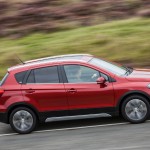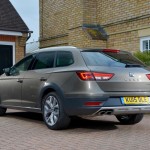The range of safety equipment fitted to today’s cars might leave you wondering how any of us managed to survive all the years in which we travelled without it.
We can see clearly some of the obvious safety aids that these days protect us, such as seat belts, and thoughtfully padded steering wheels which unlike the wood-rimmed ones of our youth are unlikely to inflict horrendous injuries when struck hard by an unrestrained human.
But today’s cars carry so much more that goes unnoticed by the majority of drivers.
Airbags for instance – it’s not unusual to have seven or eight of these fitted to even base models of a car range: front bags, side bags, and long ones at head height along the sides called curtain airbags.
There may even be one specifically targeted at the driver’s knees. All of them are inflated automatically when the system deems your collision to be sufficiently serious to warrant the protection they can offer.
But even more impressive is the list of electronic safety aids, some standard, and some soon to be so. Anti-lock brakes (known as ABS) for instance.
A development of the systems used until then in aircraft, ABS started to get a hold in car braking systems in the 1970s, but for many years it was limited to the sporting end of the market.
 If you’re unsure how it works, the simple explanation is that each wheel of the car has a sensor that monitors how the wheel is turning.
If you’re unsure how it works, the simple explanation is that each wheel of the car has a sensor that monitors how the wheel is turning.
If one of these reports to the on-board computer that the wheel is decelerating far too rapidly, the computer knows that this wheel is about to skid. It then instructs a valve in the brake pipes going to that wheel to either reduce brake pressure or even turn it off entirely.
That wheel will then turn normally and prevent the skid. Once that happens the system permits pressure to be reapplied more gently (you’ve still got your foot hard on the brake pedal) so that safe braking is restored.
In the early days of ABS this cycle of events could occur up to perhaps five times per second, and believe me from the noise and thumping of the brake pedal you knew all about it! Bear in mind that each wheel is monitored and controlled individually, so there’s a fair amount of hardware and computer power being employed.
Today the frequency is vastly higher – 15 times per second is not unusual – leading to far smoother operation, greater efficiency and a whole lot less noise.
Such is the system’s effectiveness – after all you can actually steer when the wheels aren’t skidding – it is now compulsory fitment on all new cars in the European Union.
ABS is impressive, but the more recent acronym that’s even more worthy of note is ESP.
Electronic Stability Programs are essentially a development of ABS, with even more dramatic safety benefits.
Sometimes called ESC (ES Control) or DSC (Dynamic SC), the systems require far greater computer power, since they monitor the vehicle’s intended direction (determined by the steering wheel angle), and compare it to the actual direction, which is found through the car’s lateral acceleration, the yaw (vehicle rotation), and the speed of individual wheels.
Knowing all this, the computer can establish if the driver is losing control, in other words the car isn’t going where the driver intends it should. The ESP system then applies braking to individual wheels, and can also reduce engine power, to correct the loss of control.
There’s a favourite expression we’ve all used from time to time: “it’s not rocket science”. Well ESP may not be rocket science, but it comes very close.
Such are the safety benefits of ESP, from November this year it will be mandatory fitment to all new cars sold in the EU, and the more one understands the system, the more sensible that looks.
ESP works away discreetly, and most drivers will be unaware that they have it on board. The only sign of its presence is likely to be the switch that enables one to turn it off, and you may well be wondering why anyone in their right minds would want to do that.
There are however times when it might be necessary, such as being stuck in deep snow or mud, when the continual application of ESP control might prevent you getting out of the mire.
And for those whose spare wheel is the space saving variety, you can have fun imagining what that mini wheel could do to the ESP system’s brain.
In addition to that there’s no form of motor sport in which a winning time can be achieved by a driver with ESP ‘helping out’. I’ve tried…..it’s a frustrating experience, and certainly not a lot of fun.
The above description of ESP’s operation is of course a huge over-simplification; what actually goes on is vastly more complex than this. There is however a big BUT. Impressive though ESP is, it’s important to realise that it can’t overcome the laws of physics.
If there is ultimately insufficient grip for the speed you take your car plus its safety systems into a bend, you’ll have an accident then and there. Annoying, potentially life-threatening…..and unavoidable.
by Peter Cracknell, motoring journalist




